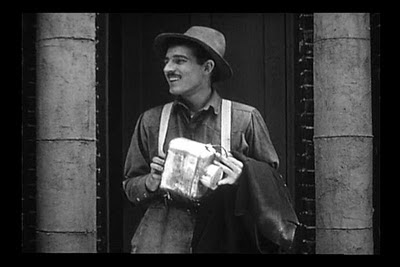In the good old days of the Nickelodeon theaters no concessions were sold in the nickelodeon theaters themselves; food or snacks were sold outside. Some nickelodeons allowed popcorn and peanut vendors who would walk up and down the aisles (much like the vendors at a baseball stadium). That was the early days and how annoying that must have been.
In the heyday of the motion picture palaces in the 1920s, no room was made for concession stands. Not with the plush seating, thick carpeting, marble floors and staff of ushers drilled with military precision. Going to see a film was an event, one which you ate before or after you saw the film. You dressed up smartly and it was quite an evening, especially for the bigger pictures at the $2 roadshow prices. That was a premium price in those days.
With the Depression movie attendance waned and movie theater owners needed to continue to attract the patrons and to also make an extra buck. The lobby space soon made room for popcorn vendors. The programs got quite a bit longer for your nickel/quarter admission price; a feature, a short or two, a cartoon, a newsreel and sometimes a second feature. By the 1940s and well into the 1950s theater owners had wised up to the profits to be made and had installed popping machines and selling other items such as candy and bottles of Coca-Cola ® and Pepsi to the hungry and thirsty crowds and intermission shorts prompted patrons to indulge.
Here is a newer, specially created retro ad for a Phoenix Theater:
The drive-in was not new, the first drive-in opened in 1933. What could be better on a warm evening in the postwar burbs with the kids in tow? Food and drink in the comfort of your Chevrolet Impala with the speaker hanging off the window. My parents indulged in this as my sister and I were growing up. I was the younger and was forced to go to the movies in my pj’s (how humiliating). They sat in the front seat imbibing cocktails from a thermos and I fell asleep in the back seat before the movie ended. Yes Virginia, it certainly was a different time then.
The subject of today's offering was a stage and screen star. His stage career blossomed to full blown stardom after a long internship in 1908, he made his screen debut in 1921 and made the successful transition from silents to talkies. He documented more than one of his signature stage roles on screen, both as a silent and talkie. The star we are dining with today is George Arliss. I also get to indulge in a little bit of local pride since the recipe below originates from San Francisco.
George Arliss was born April 10, 1868 in London, England. His acting career began about 1887. Within a few years he was playing in London on the West End, a success. He joined Mrs Patrick Campbell in 1901 and toured the U.S. George Arliss became a bona fide star on the American stage in 1908. Initially intending to stay in the U.S a short while, he stayed for twenty years. His breakout hit vehicle was in 1908 in The Devil. In 1911, producer George Tyler commissioned Louis Napoleon Parker to write a play specifically tailored for Arliss and the actor toured in Disraeli for years, becoming closely identified with the 19th century British prime minister.
Green Goddess was the hotel's signature salad dressing and for decades was served in the Palace's Garden Court Restaurant. It is served with the Dungeness Crab Salad to this day.
I offer instead another recipe I found online that was also identified as the Roemer "original." Upon testing it out, this tasted very close to the Green Goddess Dressing I grew up with. Tastebuds do not lie! In a nod to being a little more health conscious, I modified the below recipe slightly to lighten it and the dressing was no less delicious on a halved heart of romaine.
Green Goddess Dressing
2 cups of mayonnaise
1 clove of garlic
4 anchovy fillets
1 scallion, chopped
2 teaspoons chopped parsley
2 teaspoons chopped chives
2 teaspoon cut, fresh tarragon
Juice of 1 lemon
salt & pepper to taste
Place the garlic and anchovy fillets in the bowl of a food processor and pulse until minced. Add in the remaining ingredients and blend until smooth. Taste for seasoning. If you prefer the dressing to be less viscous, add a bit of water and grape seed oil to thin it. Adjust seasonings accordingly.
Serve over a classic iceberg wedge or split romaine heart. Garnish with a sprig of fresh tarragon. Enjoy!
I've got to give props to one of my new online friends and give credit to her delicious blog for partial inspiration for this series; Tinky Weisblat's In Our Grandmothers' Kitchens. Her posting Reflections of Iris Barry is very much worth reading. Iris Barry was a true pioneer among the preservationists. Food and movies are never far apart and having found Tinky's blog through the February Film Preservation Blogathon, I'm now an avid reader. I love movies and I love to cook, win-win for me.
Images of the George Arliss Green Goddess memorabilia are courtesy Robert M. Fells, author of George Arliss: The Man Who Played God.

















































